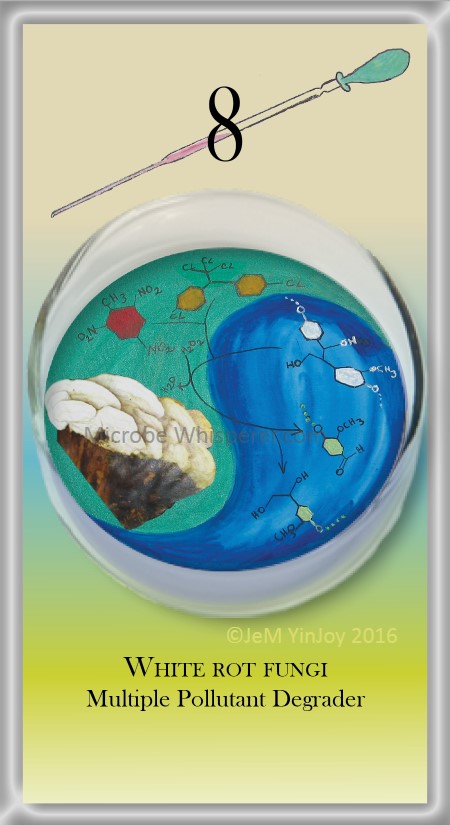
White Rot Fungi
Lovely cobwebs,
drape over desired flesh,
Drooling powerfully!
JeM YinJoy
How to pronounce Phanerochaete chrysosporium.
Phanerochaete chrysosporium (fan-er-oh-KEE-tee Cry-so-spore-e-uhm)
The Spiritual significance
P. chrysosporium forms a white cobweb after it invades a dead or dying tree, and basically breaks down woody plant material by salivating on it.
Given this, P. chrysosporium Sounds pretty much like a good candidate for mascot of Samhain, the pagan holiday when death, and decay are par for the course, and vampiric entities wander the earth in search of mortals who are vulnerable to their bite.
True to its vampiric nature, P. chrysosporium is very beautiful when looked at closely, with strings of hyphae gracefully draping themselves over their next meal.
But lest we creep out over its nature too much, let’s review our own food choices. We feed on dead animals, and dead plants. Or at least, death comes to the plants we do consume. Even eating fruits and vegetables creates a death of some kind.
In our ancient past, the hunters preyed on the weaker animals in the herd.
So we as consumers of flora and fauna have the same MO as the P. chrysosporium does, expect we keep our saliva hidden in our mouths.
P. Chrysosporium has very powerful enzymes in its external secretions, that not only break down the woody plant material but also can break down chemicals that are bad for the environment, like PCBs.
So the teaching of P. Chrysosporium is this – Do not cast aspersions on others as you yourself may be guilty of the acts you are judging so harshly.
And, make sure when you develop a powerful talent or achieve a powerful position, that you are generous to your community and wield that power where it does the most good.
The Microbiology
Phanerochaete chrysosporium is the model white rot fungus because of its specialized ability to degrade the abundant aromatic polymer lignin, while leaving the white cellulose nearly untouched. Phanerochaete chrysosporium releases extracellular enzymes to break-up the complex three-dimensional structure of lignin into components that can be utilized by its metabolism. The extracellular enzymes are non-specific oxidizing agents (hydrogen peroxide, hydroxyl radicals) used to cleave the lignin bonds.
Due to Phanerochaete chrysoporium’s specialized degradation abilities, research is focussed how to use this fungus to degrade a diverse range of pollutants.
Shape and size –
Phanerochaete chrysosporium is a crust fungus, which forms flat fused reproductive fruiting bodies instead of the mushroom structure. These fungi exhibit an interesting pattern of septate hyphae, giving a stronger line of defense in times of distress. The hyphae network has some branching, with diameters ranging from 3-9 µm. At the ends of the hyphae rest chlamydospores, thick-walled spores varying from 50-60 µm. The conidiophore gives rise to round asexual blastoconidia, which are 6-9 µm in diameter.
Habitat – This white-rot fungus can be found in forests ranging from North America, to areas of Europe and in Iran.









